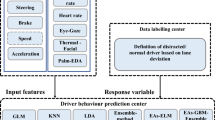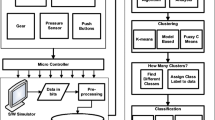Abstract
Awareness and attention of drivers while driving show a vital role in decreasing the number of collisions. In the modern decades, in-car entertainment is a major cause of degradation of drivers' performance and losing consciousness. However, there are other factors such as drowsiness and tiredness that have an important part as well. Earlier detection of this degradation in behavior can be used to provide suggestions to the driver while driving. The main motive behind the work is to mitigate the effects of manually labeling the data which costs lot of time and also would result in inaccurate labels. The proposed work has 2 parts: Feature reconstruction and Stacking for classification. The Feature reconstruction phase involves clustering of data from different sensors and labeling the style of driving. Then ensemble-based Stacking classifiers which are optimized with artificial bee colony algorithm is adopted for the driving style classification. The performance analysis is done by applying the stacking classifier to data from OBD. The Stacking classifier is able to achieve an accuracy of above 98% irrespective of the classical learning algorithms.











Similar content being viewed by others
Data availability
Data sharing is not applicable to this article as no new data were created or analyzed in this study.
References
Al-Din MN, Aljaafreh A, Albdour N, Saleh M (2013) Driving styles recognition using decomposed fuzzy logic system. Int J Electr Electr Comput Syst (IJEECS) 16(1):820–824
Ali AH, Atia A, Mostafa MS (2017) Recognizing driving behavior and road anomaly using smartphone sensors. Int J Ambient Comput Intell (IJACI) 8(3):22–37
Aljaafreh A, Alshabatat N, Al-Din MSN (2012) Driving style recognition using fuzzy logic, Vehicle Electr Safety (ICVES), pp. 460–463
Bijman J (2017) Cluster driving behaviour and assigning clusters to safe and unsafe driving behaviour through raw GPS trajectory data. Master thesis Data Science in Action, Tilburg University School of Humanities
Carmona J, de Miguel MA, Martin D, Garcia F, de la Escalera, A (2016) Embedded system for driver behavior analysis based on gmm. In: 2016 IEEE Intelligent Vehicles Symposium (IV) (pp. 61–65)
Castignani G, Frank R, Engel T (2013) An evaluation study of driver profiling fuzzy algorithms using smartphones, In Proc 21st IEEE Int Conf Netw Protocols (ICNP), pp. 1–6
Chen Y, Wong ML (2011) Optimizing stacking ensemble by an ant colony optimization approach. In: Proceedings of the 13th annual conference companion on genetic and evolutionary computation. Dublin, Ireland, pp. 7e8
Ellison AB, Greaves SP, Bliemer MCJ (2015) Driver behaviour profiles for road safety analysis. Accid Anal Prev 76:118–132
Ferreira J, Carvalho E, Ferreira BV, de Souza C, Suhara Y, Pentland A, Pessin G (2017) Driver behavior profiling: an investigation with different smartphone sensors and machine learning. PLOS One, 12(4), Article e0174959
Guo HY, Ji Y, Qu T, Chen H (2013) Understanding and modeling the human driver behavior based on MPC, In Proceedings 7th IFAC Symp Adv Autom Control, Tokyo, Japan, pp. 133–138
Hartigan JA, Wong MA (1979) Algorithm AS 136: a k-means clustering algorithm. J Royal Stat Soc Series C (Appl Stat). 28(1): 100–8
Husnjak S, Peraković D, Forenbacher I, Mumdziev M (2015) Telematics system in usage based motor insurance. Procedia Eng 100:816–825
Karaboga D (2010) Artificial Bee Colony Algorithm. Scholarpedia 5(3):6915
Kim HS, Hwang YS, Yoon DS, Choi WG, Park CH (2014) Driver workload characteristics analysis using EEG data from an urban road. IEEE Trans Intell Transp Syst 15(4):1844–1849
Kwak BI, Woo J, Kim HK (2016) Know your master: driver profiling-based anti-theft method. In 2016 14th Annual Conference on Privacy, Security and Trust (PST) 2016 Dec 12 (pp. 211–218). IEEE.
Lattanzi E, Freschi V (2021) Machine learning techniques to identify unsafe driving behavior by means of in-vehicle sensor data. Expert Syst Appl 15(176):114818
Li G, Li SE, Cheng B, Green P (2017) Estimation of driving style in naturalistic highway traffic using maneuver transition probabilities. Trans Res Part c: Emerg Technol 74:113–125
Liao Y, Wang M, Duan L, Chen F (2018) Cross-regional driver—vehicle interaction design: an interview study on driving risk perceptions, decisions, and ADAS function preferences. IET Intell Transp Syst 12(8):801–808
Ma Y, Li Z, Li Y et al (2019) Driving style estimation by fusing multiple driving behaviors: a case study of freeway in China. Cluster Comput 22:8259–8269
Nirmali SB, Wickramasinghe S, Munasinghe T, Amalraj CR, Bandara HD (2017) Vehicular data acquisition and analytics system for real-time driver behavior monitoring and anomaly detection. In 2017 IEEE International Conference on Industrial and Information Systems (ICIIS) 2017 Dec 15 (pp. 1–6). IEEE
Refaeilzadeh P, Tang L, Liu H (2009) Cross-Validation. Encyclopedia Database Syst 5:532–538
Romera E, Bergasa LM, Arroyo R (2016) Need data for driver behaviour analysis? Presenting the public uah-driveset, In Intelligent Transportation Systems (ITSC), 2016 IEEE 19th International Conference on. IEEE, pp. 387–392
Saleh K, Hossny M, Nahavandi S (2017) Driving Behavior classification based on sensor data fusion using LSTM recurrent neural networks, In Proc IEEE 20th Int Conf Intell Transp Syst (ITSC), pp. 1–6
Shahverdy M, Fathy M, Berangi R, Sabokrou M (2020) Driver behavior detection and classification using deep convolutional neural networks. Expert Syst Appl, 149, Article 113240
Shunmugapriya P, Kanmani S (2013) Optimization of stacking ensemble configurations through artificial bee colony algorithm. Swarm Evol Comput 12:24e32
Srinivasan D, Jin X, Cheu RL (2005) Adaptive neural network models for automatic incident detection on freeways. Neurocomputing 64(1–4):473–496
Vaitkus V, Lengvenis P, Zylius G (2014) Driving style classification using long-term accelerometer information, In Methods and Models in Automation and Robotics (MMAR), 19th International Conference On. IEEE, pp. 641–644
Wang W, Xi J, Chong A, Li L (2017) Driving style classification using a semisupervised support vector machine. IEEE Trans Human-Mach Syst 47(5):650–660
Wang W, Xi J (2016) A rapid pattern-recognition method for driving styles using clustering-based support vector machines. In 2016 American Control Conference (ACC) (pp. 5270–5275). IEEE
Wolpert DH (1992) Stacked generalization. Neural Netw 5(2):241e259
Funding
For such a research, the author(s) did not receive any specific funding.
Author information
Authors and Affiliations
Contributions
PG: Study conception, Design, Data collection, Analysis; FUM: Interpretation of results and manuscript preparation.
Corresponding author
Ethics declarations
Conflict of interest
The authors have no relevant financial or non-financial interests to disclose.
Additional information
Communicated by Meng Joo.
Publisher's Note
Springer Nature remains neutral with regard to jurisdictional claims in published maps and institutional affiliations.
Rights and permissions
About this article
Cite this article
Priyadharshini, G., Ukrit, M.F. Stacking optimized with artificial bee colony for driving style classification by feature reconstruction from OBD II data. Soft Comput 27, 591–603 (2023). https://doi.org/10.1007/s00500-022-07135-3
Accepted:
Published:
Issue Date:
DOI: https://doi.org/10.1007/s00500-022-07135-3




